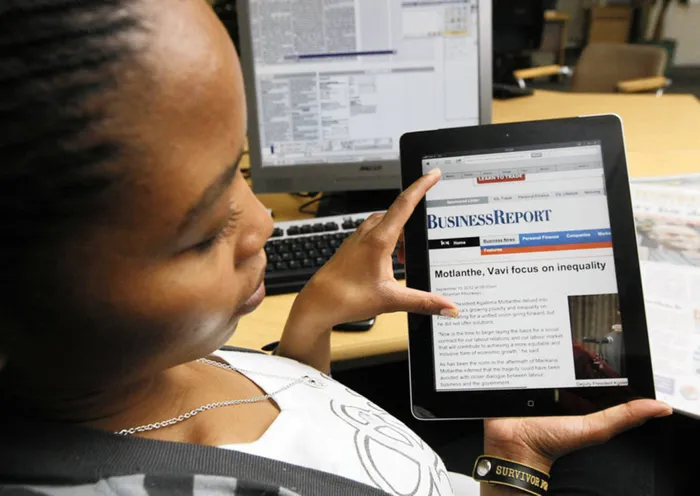Rethinking the future of media: a case for a reimagined newspaper in the age of digital overload

10/09/12 Seanokeng Molosankwe reading Business Report copy on her Ipad 2 in JHB. Photo: Leon Nicholas Seanokeng Molosankwe reading Business Report copy on her Ipad 2 in JHB.
Image: Leon Nicholas /Independent Newspapers.
In a world increasingly defined by immediacy, interconnectivity, and relentless information streams, traditional media—particularly newspapers—face existential questions.
Yet, despite decades of predictions proclaiming the death of print, newspapers continue to persist. The question now is not whether newspapers will survive, but how they must evolve to remain relevant.
As we stand at the intersection of digital fatigue and content abundance, there is a compelling case to reimagine the role of newspapers—not as relics of the past, but as curated, future-focused knowledge platforms that prioritize depth over speed, clarity over clutter, and insight over immediacy.
The evolution of media: from press to platform
To understand the future of newspapers, we must first revisit the evolution of media itself.
Historically, newspapers were the gatekeepers of information. The printing press democratized knowledge, and newspapers shaped public opinion, defined narratives, and held power to account. Then came radio, followed by television—each platform bringing news faster and to wider audiences. The digital revolution, however, upended everything.
The rise of the internet and, subsequently, social media platforms, created a 24/7 news ecosystem. News consumption became non-linear, decentralized, and user-driven. Algorithms replaced editors, clicks replaced subscriptions, and virality often trumped veracity.
And yet, amid all this, one truth endured: content remains constant. Audiences, despite being overwhelmed, still seek credible, quality content that adds value to their lives.
Digital overload and the relevance of print
We are now in an era of digital overload—a term that encapsulates the cognitive fatigue from constant notifications, breaking news, and endless scrolling. Information is abundant but wisdom is scarce. We are connected, but not always informed.
In such a world, print—once seen as archaic—offers something digital cannot: a pause.
Newspapers in print format provide a finite, structured, and distraction-free experience. The tactile act of turning a page encourages focus and reflection. There is a growing niche of readers—especially among professionals, educators, and even Gen Z—who are rediscovering the calm and depth offered by physical newspapers and journals.
A Harvard Business Review piece in recent years noted a return to “slow media” as a counter-response to the velocity of digital consumption. This does not mean rejecting digital but rather complementing it with formats that enable thoughtful engagement.
Rethinking the Newspaper: Yesterday, Today, and Tomorrow
So, how should newspapers adapt?
Imagine a newspaper that devotes:
20% to Yesterday: Offering rich context and analysis of events that have already happened. Not breaking news, but “why it matters” stories. This can include timelines, expert commentary, and fact-checked recaps.
30% to Today: Reporting on current events, policy shifts, business, culture, and community matters—but framed through the lens of relevance and impact.
50% to the Future: A bold pivot where the majority of content is forward-looking. Think emerging technologies, education, future of work, climate science, innovation in Africa, and trend forecasting. This positions the newspaper not just as a record of the past, but a map for tomorrow.
This editorial philosophy not only differentiates the newspaper from fleeting social content but also cultivates a loyal readership who see value in curated knowledge rather than fragmented information.
A case for smaller circulations with bigger impact
The era of mass print circulation is over. But the age of purposeful circulation is just beginning.
In an age of hyper-targeted content and personalized feeds, the goal should not be to reach everyone, but to deeply engage with a defined audience. A smaller print run can be sustainable—if it is backed by high-quality content, strong branding, and strategic distribution.
Think of premium newspapers and journals such as The Financial Times Weekend, Monocle, New York Times Review, or even regional publications with niche influence. Their readerships are loyal because they trust the curation, not just the content.
Print, in this context, becomes a luxury good—not in terms of price, but in the value of experience it offers. Limited circulation, high production quality, and thoughtful design can turn newspapers into collectible, referable products.
Platform agnostic, audience obsessed
One of the enduring lessons of the last two decades is that platforms will change, but audience needs are constant.
Whether it’s a website, app, podcast, newsletter, or print edition, what matters is that the content:
- Meets real needs (educational, emotional, or informational),
- Respects the audience’s time and intelligence, and
- Adds long-term value to their lives.
Newsrooms should no longer define themselves by the medium, but by the mission—to inform, educate, and inspire.
Embracing the hybrid future
The future of newspapers lies in hybrid models:
- Print editions released weekly or monthly, with emphasis on future-focused content and deep analysis.
- Digital extensions that include live updates, interactive features, and reader communities.
- Events, podcasts, and partnerships that expand the brand beyond the page.
- Data-driven insights to better understand and serve readers—without succumbing to clickbait culture.
This hybrid model allows newspapers to move from being passive distributors of news to becoming active knowledge hubs and cultural conveners.
Conclusion: A New Kind of Newspaper for a New Kind of Reader
In 10 or 20 years, we may not call them “newspapers” anymore. But the need for structured, credible, and curated media will remain.
In a world grappling with the consequences of too much information, the next great media innovation might not be a new platform—it might be a return to intentional publishing.
The future belongs to those who can offer clarity amid chaos, vision amid noise, and perspective amid panic. A newspaper that carries 20% of yesterday, 30% of today, and 50% of tomorrow is not only possible—it is necessary.

Mike Ntsasa (CPRP)| Executive at Independent Media.
Image: File.